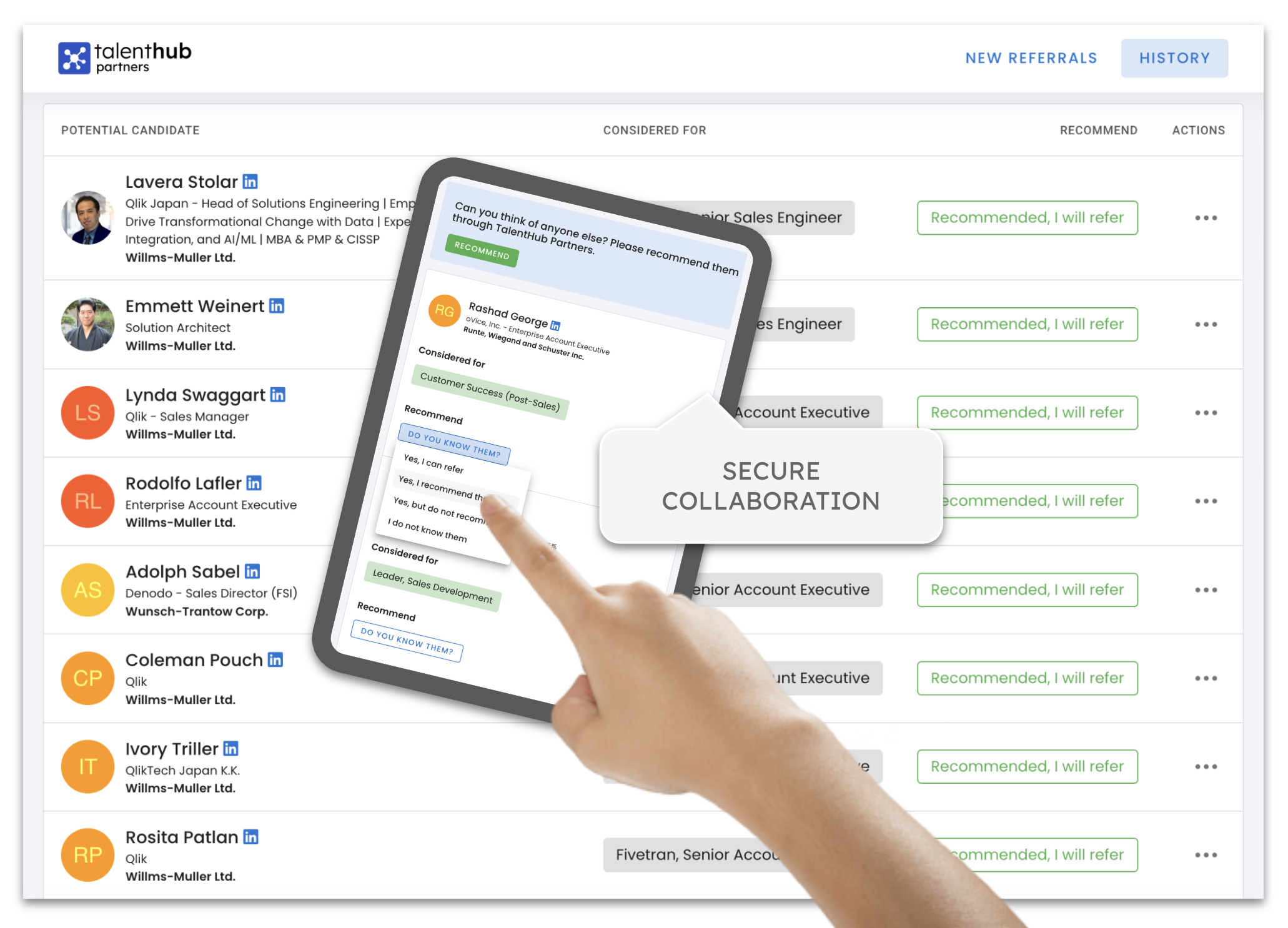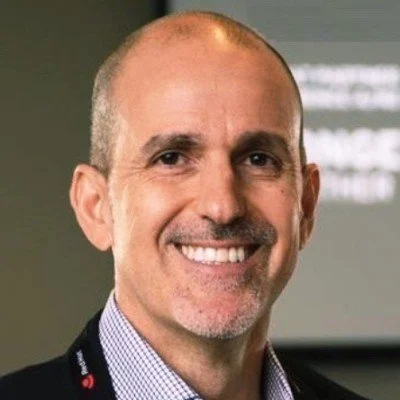
Referral Mapping: Unlocking the Hidden Network
Move beyond passive referrals. Proactive mapping makes it simple to surface quality candidates through recognition, not recall – faster, more secure, and with collaboration tools that turn employee networks into a repeatable hiring advantage.

Why this matters
Proactively Pursue the Right Talent
Most referral programmes are passive. A recruiter sends out a blanket email – “Does anyone know someone for this role?” – and hopes for replies. The outcome is predictable: silence, or a few obvious names recycled each time. This wastes time, misses hidden networks, and delivers inconsistent results.
Market-leading talent acquisition teams take a very different approach. They proactively canvas the market, working closely with employees and managers to identify the best people to pursue. This shifts the applicant base from whoever happens to apply to the candidates you actively choose to attract.
Proactive referral mapping turns referrals into a strategic channel. By systematically surfacing the right names and giving staff the tools to make introductions, you access higher-quality candidates, shorten time-to-hire, and increase the likelihood of long-term success. In Japan’s tight talent market, this is the difference between referrals being a nice-to-have and referrals becoming a decisive hiring advantage.
Proactively Target Quality Talent
Your referral strategy needs to be proactive, not passive.
Asking “does anyone know anyone?” rarely works. It relies on memory recall, produces a handful of obvious names, and leaves most of the network untapped.
The difference between noise and a referral channel that delivers comes down to four things: mapping networks, surfacing names through recognition, enabling secure mobile collaboration, and protecting data. Get these right, and referrals become a repeatable sourcing engine – one our RPO recruiters and platform make simple.
The problem with passive referrals
There are several major problems with most passive referral programs:
Low recall – employees rarely remember all the people they know when asked cold.
One-off effort – interest fades after the first request, and momentum disappears if the recruiter leaves.
Lost IP – spreadsheets and inboxes don’t scale and aren’t retained as corporate assets.
The outcome is a trickle of referrals, mostly limited to an employee’s current close contacts, leaving 90% of potential value untouched.
Proactive referral mapping
Referable was built to solve these issues. Instead of relying on memory recall, it works on recognition. Employees are prompted with names of people they’ve worked with or know by reputation. A simple click is enough to confirm whether someone is referable, recommendable, or not suitable.
This shift from recall to recognition makes the process dramatically more effective:
More names surfaced – because recognition triggers instant memory.
Quality filters – employees help qualify who is worth pursuing and who is not.
Speed – shortlists can be built in minutes, not weeks.
In trials, recruiters found one in every five names shared came back as genuinely referable – delivering up to 80% efficiency gains.
Talent mapping in practice
With Referable, recruiters and RPO teams can:
Build talent maps of pre-qualified candidates linked to employee networks.
Differentiate between referrals (direct introductions) and recommendations (leads the recruiter should scout).
Secure referral IP in the platform, so knowledge isn’t lost when recruiters or employees move on.
Use dashboards to track activity, identify who is collaborating, and show progress to hiring managers.
This structured approach doesn’t just produce more names. It produces better hires – with lower fail rates at interview, stronger cultural fit, and higher long-term performance.
Collaboration made easy
The platform is mobile-first and designed for simplicity. It works seamlessly across devices – phone, tablet, or desktop – so employees can respond wherever they are. Instead of scheduling meetings or filling in spreadsheets, they simply review shortlists and give feedback with a few clicks. It takes seconds, not hours.
Security is built-in. Sharing is controlled, data is encrypted in transit, and only public information is surfaced – so employees don’t feel like they’re giving away private networks. This creates a safe environment where collaboration feels natural, not forced.
Feedback from users is consistent: it’s “super easy” and it surfaces people they hadn’t thought of until they saw the name. Recruiters describe it as a tool they “love” because it transforms a manual, frustrating process into one that just works – quickly, securely, and at scale.
Compliance and trust – building confidence into referrals
Backdoor checks may feel tempting, but once someone becomes a candidate or applicant, they create compliance risks. Our model avoids this by keeping referrals consent-driven, secure, and transparent. Data is encrypted, only public information is surfaced, and candidates are part of the process.
The result: faster, more confident hiring decisions without legal or ethical grey areas. Compliance isn’t a hurdle – it’s what makes your referral program credible and effective.
What this means for leaders
A Targeted, Proactive Referral program
Traditional referral programs ask employees to recall names on demand. The result is shallow pipelines, inconsistent quality, and missed opportunities. Proactive referral mapping flips this model. By using recognition rather than recall, and by making the process mobile-first, secure, and instant, you turn employee networks into a repeatable sourcing engine.
For leaders, this means:
Speed – high-quality referrals surfaced in seconds, without meetings or spreadsheets.
Security – controlled sharing, encrypted data, only public information exposed.
Consistency – a growing corporate asset, not a one-off spreadsheet lost when people leave.
Quality – hires made through mapped referrals onboard faster, stay longer, and perform better.
Passive programs generate noise. Proactive referral mapping delivers signal – a structured, collaborative process that surfaces talent you already trust, faster than the open market. For companies scaling in Japan, this is not optional. It’s a competitive advantage.

Discussion:
Hiring From Partners
Hiring from partners and domestic firms unlocks proven talent.
Done transparently, it accelerates growth without damaging key relationships. Startups often set a high English bar, but as you scale, this can be lowered to access a deeper pool of high-impact candidates.
Hiring high performers from Japanese companies and partners is a proven but rarely discussed strategy. Many of today’s leaders in global tech built their careers this way. These candidates bring deep market knowledge but face limited mobility and compensation in domestic firms. Referrals and partner networks are the best way to identify them, but it must be handled carefully to protect relationships. With transparency and strategy, this channel delivers talent that accelerates growth far faster than job boards.
Hiring from Partners and Japanese Companies:
☐ Largest talent pool with high-quality skills and market knowledge
☐ Many top leaders in global tech came from firms like NEC, Fujitsu, SIers
☐ Referrals through partners surface proven, high-impact talent
☐ English is often the hurdle – critical for startups, flexible at scale
☐ Must be handled transparently to protect partner relationships
☐ A strategic channel few discuss, but every vendor uses
Trust Earned, Not Claimed






















